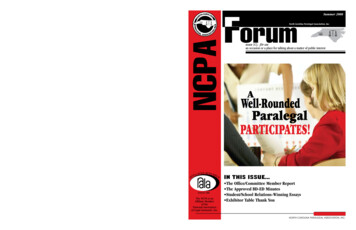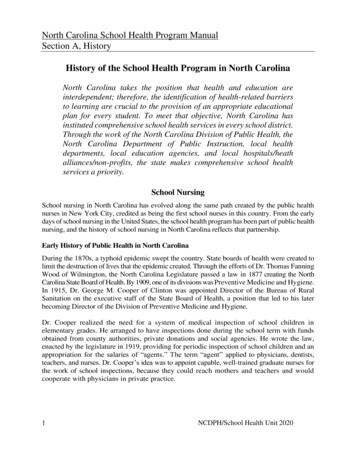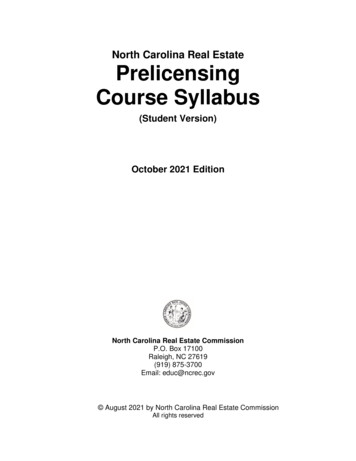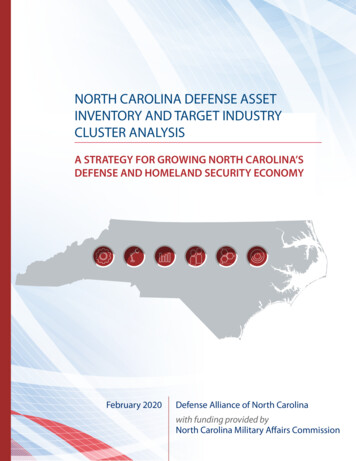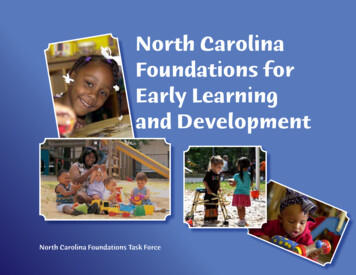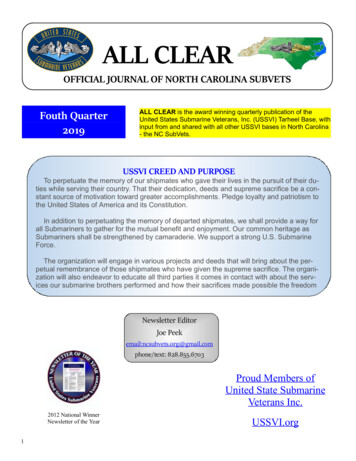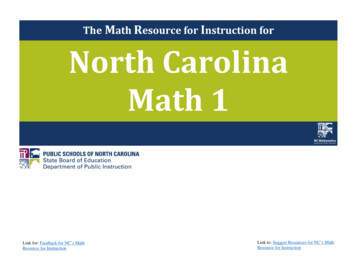
Transcription
The Math Resource for Instruction forNorth CarolinaMath 1Link for: Feedback for NC’s MathResource for InstructionLink to: Suggest Resources for NC’s MathResource for Instruction
North Carolina Math 1 StandardsNumberThe real number systemExtend the properties of exponentsNC.M1.N-RN.2AlgebraOverviewSeeing structure in expressionsInterpret the structure of expressionsNC.M1.A-SSE.1aNC.M1.A-SSE.1bWrite expressions in equivalent formsto solve problemsNC.M1.A-SSE.3Perform arithmetic operations onpolynomialsPerform arithmetic operations onpolynomialsNC.M1.A-APR.1Understand the relationship betweenzeros and factors of polynomialsNC.M1.A-APR.3Creating EquationsCreate equations that describenumbers or .3NC.M1.A-CED.4AlgebraReasoning with equations andinequalitiesUnderstand solving equations as aprocess of reasoning and explain thereasoningNC.M1.A-REI.1Solve equations and inequalities inone variableNC.M1.A-REI.3NC.M1.A-REI.4Solve systems of equationsNC.M1.A-REI.5NC.M1.A-REI.6Represent and solve equations andinequalities .12FunctionsOverviewInterpreting FunctionsUnderstand the concept of a functionand use function ret functions that arise inapplications in terms of a contextNC.M1.F-IF.4NC.M1.F-IF.5NC.M1.F-IF.6Analyze functions using C.M1.F-IF.8bNC.M1.F-IF.9Building FunctionsBuild a function that models arelationship between two near, Quadratics andExponential ModelsConstruct and compare linear andexponential models to solve problemsNC.M1.F-LE.1NC.M1.F-LE.3Interpret expressions for functions interms of the situations they modelNC.M1.F-LE.5The Math Resource for Instruction for NC Math 1GeometryOverviewExpressing geometric propertieswith equationsUse coordinates to prove simplegeometric theorems .6Statistics & ProbabilityOverviewInterpreting Categorical andQuantitative DataSummarize, represent, and interpretdata on a single count ormeasurement ize, represent, and interpretdata on two categorical andquantitative terpret linear , March 9, 2017
Number – The Real Number SystemNC.M1.N-RN.2Extend the properties of exponents.Rewrite algebraic expressions with integer exponents using the properties of exponents.Concepts and SkillsPre-requisite Using the properties of exponents to create equivalent numericalexpressions (8.EE.1)Connections Use operations to rewrite polynomial expressions (NC.M1.A-APR.1)The Standards for Mathematical PracticesConnectionsGenerally, all SMPs can be applied in every standard. The following SMPs can behighlighted for this standard.7 – Look for and make use of structure8 – Look for and express regularity in repeated reasoningDisciplinary LiteracyAs stated in SMP 6, the precise use of mathematical vocabulary is the expectationin all oral and written communication.Vocabulary – base, exponent, indexStudents should be able to justify their steps in rewriting algebraic expressions.Mastering the StandardComprehending the StandardStudents extend the properties ofinteger exponents learned inmiddle school with numericalexpressions to algebraicexpressions.Assessing for UnderstandingStudents should be able to use the properties of exponents to write expression into equivalent forms.Example: Rewrite the following with positive exponents:a) (8𝑥𝑥 4 𝑦𝑦 3 )( 2𝑥𝑥 5 𝑦𝑦 6 )2The process of “simplifyingsquare roots” is not anexpectation for Math 1 studentsIn Math 2, students will extendthe properties of exponents torational exponents and rewrite,“simplify” all square roots.Students should be able to use the new skills of applying the properties of exponents with skills learned in previous courses.Example: Simplify: 25𝑚𝑚14 𝑝𝑝2 𝑡𝑡 4In 8th grade, students learned to evaluate the square roots of perfect squares and the cube root of perfect cubes. In Math 1,students can combine this previous skill with algebraic expressions. When addressing a problem like this in Math 1, studentsshould be taught to rewrite the expression using the properties of exponents and then using inverse operations to rewrite. Forexample, 𝑚𝑚14 (𝑚𝑚7 )2 𝑚𝑚7 .In Math 1, the limitation from 8th grade of evaluating square roots of perfect squares and cube root of perfect cubes still applies.b) 3𝑚𝑚2 𝑝𝑝 2 𝑞𝑞 9𝑚𝑚 3 𝑞𝑞 33Instructional ResourcesAdditional ResourcesTasksRaising to the Zero and Negative Power (Illustrative Mathematics) NEWBack to: Table of ContentsThe Math Resource for Instruction for NC Math 1Thursday, March 9, 2017
Algebra, Functions & Function FamiliesNC Math 1NC Math 2NC Math 3Functions represented as graphs, tables or verbal descriptions in contextFocus on comparing properties of linearfunction to specific non-linear functions andrate of change. Linear Exponential QuadraticFocus on properties of quadratic functionsand an introduction to inverse functionsthrough the inverse relationship betweenquadratic and square root functions. Quadratic Square Root Inverse VariationA focus on more complex functions Exponential Logarithm Rational functions w/ linear denominator Polynomial w/ degree three Absolute Value and Piecewise Intro to Trigonometric FunctionsA Progression of Learning of Functions through Algebraic ReasoningThe conceptual categories of Algebra and Functions are inter-related. Functions describe situations in which one quantity varies withanother. The difference between the Function standards and the Algebra standards is that the Function standards focus more on thecharacteristics of functions (e.g. domain/range or max/min points), function definition, etc. whereas the Algebra standards provide thecomputational tools and understandings that students need to explore specific instances of functions. As students progress through highschool, the coursework with specific families of functions and algebraic manipulation evolve. Rewriting algebraic expressions to createequivalent expressions relates to how the symbolic representation can be manipulated to reveal features of the graphical representation ofa function.Note: The Numbers conceptual category also relates to the Algebra and Functions conceptual categories. As students become more fluentwith their work within particular function families, they explore more of the number system. For example, as students continue the study ofquadratic equations and functions in Math 2, they begin to explore the complex solutions. Additionally, algebraic manipulation within thereal number system is an important skill to creating equivalent expressions from existing functions.Back to: Table of ContentsThe Math Resource for Instruction for NC Math 1Thursday, March 9, 2017
Algebra – Seeing Structure in ExpressionsNC.M1.A-SSE.1aInterpret the structure of expressions.Interpret expressions that represent a quantity in terms of its context.a. Identify and interpret parts of a linear, exponential, or quadratic expression, including terms, factors, coefficients, and exponents.Concepts and SkillsPre-requisite Identify parts of an expression using precise vocabulary (6.EE.2b) Interpret numerical expressions written in scientific notation (8.EE.4) For linear and constant terms in functions, interpret the rate of change andthe initial value (8.F.4)Connections Creating one and two variable equations (NC.M1.A-CED.1, NC.M1.ACED.2, NC.M1.A-CED.3) Interpreting part of a function to a context (NC.M1.F-IF.2, NC.M1.F-IF.4,NC.M1.F-IF5, NC.M1.F-IF.7, NC.M1.F-IF.9) Interpreting changes in the parameters of a linear and exponential functionin context (NC.M1.F-LE.5)Comprehending the StandardThe set of A-SSE standards requires students: to write expressions in equivalentforms to reveal key quantities in termsof its context. to choose and use appropriatemathematics to analyze situations.For this part of the standards, studentsrecognize that the linear expression 𝑚𝑚𝑚𝑚 𝑏𝑏 hastwo terms, that m is a coefficient, and b is aconstant.Students are expected to recognize the parts ofa quadratic expression, such as the quadratic,linear and constant term, or factors.For exponential expressions, students shouldrecognize factors, the base, and exponent(s).Students extend beyond simplifying to interpretthe components of an algebraic expression.The Standards for Mathematical PracticesConnectionsGenerally, all SMPs can be applied in every standard. The following SMPs can behighlighted for this standard.2 – Reason abstractly and quantitatively.4 – Model with mathematics7 – Look for and make use of structure.Disciplinary LiteracyAs stated in SMP 6, the precise use of mathematical vocabulary is the expectationin all oral and written communication.New Vocabulary: Quadratic term, exponential termMastering the StandardAssessing for UnderstandingStudents should recognize that in the expression 2𝑥𝑥 1, “2” is the coefficient, “2” and “x” are factors, and “1” is aconstant, as well as “2x” and “1” being terms of the binomial expression. Also, a student recognizes that in the expression4(3)𝑥𝑥 , 4 is the coefficient, 3 is the factor, and x is the exponent. Development and proper use of mathematical language isan important building block for future content. Using real-world context examples, the nature of algebraic expressionscan be explored.Example: The height (in feet) of a balloon filled with helium can be expressed by 5 6.3𝑠𝑠 where s is the number ofseconds since the balloon was released. Identify and interpret the terms and coefficients of the expression.Example: The expression 4.9𝑡𝑡 2 17𝑡𝑡 0.6 describes the height in meters of a basketball t seconds after it hasbeen thrown vertically into the air. Interpret the terms and coefficients of the expression in the context of thissituation.Example: The expression 35000(0.87)𝑡𝑡 describes the cost of a new car 𝑡𝑡 years after it has been purchased. Interpretthe terms and coefficients of the expression in the context of this situation.The Math Resource for Instruction for NC Math 1Thursday, March 9, 2017
TasksDelivery Trucks (Illustrative Mathematics)Instructional ResourcesAdditional ResourcesInterpreting Algebraic Expressions (Mathematics Assessment Project – FAL)Back to: Table of ContentsThe Math Resource for Instruction for NC Math 1Thursday, March 9, 2017
Algebra – Seeing Structure in ExpressionsNC.M1.A-SSE.1bInterpret the structure of expressions.Interpret expressions that represent a quantity in terms of its context.b.Interpret a linear, exponential, or quadratic expression made of multiple parts as a combination of entities to give meaning to anexpression.Concepts and SkillsPre-requisite Interpret a sum, difference, product, and quotient as a both a whole and as acomposition of parts (6.EE.2b) Understand that rewriting expressions into equivalent forms can revealother relationships between quantities (7.EE.2) Interpret numerical expressions written in scientific notation (8.EE.4)The Standards for Mathematical PracticesConnectionsGenerally, all SMPs can be applied in every standard. The following SMPs can behighlighted for this standard.2 – Reason abstractly and quantitatively.4 – Model with mathematics7 – Look for and make use of structure.Connections Factor to reveal the zeros of functions and solutions to quadratic equations(NC.M1.A.SSE.3) Creating one and two variable equations (NC.M1.A-CED.1, NC.M1.ACED.2, NC.M1.A-CED.3) Interpreting part of a function to a context (NC.M1.F-IF.2, NC.M1.F-IF.4,NC.M1.F-IF5, NC.M1.F-IF.7, NC.M1.F-IF.9) Interpreting changes in the parameters of a linear and exponential functionin context (NC.M1.F-LE.5)Disciplinary LiteracyAs stated in SMP 6, the precise use of mathematical vocabulary is the expectationin all oral and written communication.Comprehending the StandardThe set of A-SSE standards requires students: to write expressions in equivalentforms to reveal key quantities in termsof its context. to choose and use appropriatemathematics to analyze situations.Students identify parts of an expression as asingle quantity and interpret the parts in termsof their context.New Vocabulary: exponential expression, quadratic expressionMastering the StandardAssessing for UnderstandingStudents should understand that working with unsimplified expressions often reveals key information from acontext.Example: The expression 20(4𝑥𝑥) 500 represents the cost in dollars of the materials and labor needed to build asquare fence with side length x feet around a playground. Interpret the constants and coefficients of the expression incontext.Example: A rectangle has a length that is 2 units longer than the width. If the width is increased by 4 units and thelength increased by 3 units, write two equivalent expressions for the area of the rectangle.Solution: The area of the rectangle is (𝑥𝑥 5)(𝑥𝑥 4) 𝑥𝑥 2 9𝑥𝑥 20. Students should recognize (𝑥𝑥 5) as thelength of the modified rectangle and (𝑥𝑥 4) as the width. Students can also interpret 𝑥𝑥 2 9𝑥𝑥 20 as the sum of thethree areas (a square with side length x, a rectangle with side lengths 9 and x, and another rectangle with area 20 thathave the same total area as the modified rectangle.The Math Resource for Instruction for NC Math 1Thursday, March 9, 2017
Comprehending the StandardMastering the StandardAssessing for UnderstandingExample: Given that income from a concert is the price of a ticket times each person in attendance, consider theequation 𝐼𝐼 4000𝑝𝑝 250𝑝𝑝2 that represents income from a concert where p is the price per ticket. What expressioncould represent the number of people in attendance?Solution: The equivalent factored form, 𝑝𝑝 (4000 250𝑝𝑝), shows that the income can be interpreted as the pricetimes the number of people in attendance based on the price charged. Students recognize (4000 250𝑝𝑝) as a singlequantity for the number of people in attendance.Example: The expression 10,000(1.055)𝑛𝑛 is the amount of money in an investment account with interestcompounded annually for n years. Determine the initial investment and the annual interest rate.Note: The factor of 1.055 can be rewritten as (1 0.055), revealing the growth rate of 5.5% per year.TasksInstructional ResourcesAdditional ResourcesFAL: Generating Polynomials from Patterns (Math Assessment Project) NEWBack to: Table of ContentsThe Math Resource for Instruction for NC Math 1Thursday, March 9, 2017
Algebra – Seeing Structure in ExpressionsNC.M1.A-SSE.3Write expressions in equivalent forms to solve problems.Write an equivalent form of a quadratic expression by factoring, where 𝑎𝑎 is an integer of the quadratic expression, 𝑎𝑎𝑎𝑎2 𝑏𝑏𝑏𝑏 𝑐𝑐, to reveal thesolutions of the equation or the zeros of the function the expression defines.Concepts and SkillsPre-requisite Factoring and expanding linear expressions with rational coefficients(7.EE.1) Understand that rewriting expressions into equivalent forms can revealother relationships between quantities (7.EE.2)Connections Interpreting the factors in context (NC.M1.A-SSE.1b) Understanding the relationship between factors, solutions, and zeros(NC.M1.A-APR.3) Solving quadratic equations (NC.M1.A-REI.4) Rewriting quadratic functions into different forms to show key features ofthe function (NC.M1.F-IF.8a)Comprehending the StandardStudents factor a quadratic in the form 𝑎𝑎𝑥𝑥 2 𝑏𝑏𝑏𝑏 𝑐𝑐 where 𝑎𝑎 is an integer in order to revealthe zeroes of the quadratic function.Students use the linear factors of a quadraticfunction to explain the meaning of the zeros ofquadratic functions and the solutions toquadratic equations in a real-world problem.The Standards for Mathematical PracticesConnectionsGenerally, all SMPs can be applied in every standard. The following SMPs can behighlighted for this standard.4 – Model with mathematics7 – Look for and make use of structure.Disciplinary LiteracyAs stated in SMP 6, the precise use of mathematical vocabulary is the expectationin all oral and written communication.Students should be able to compare and contrast the zeros of a function and thesolutions of a function.New Vocabulary: quadratic expression, zeros, linear factorsMastering the StandardAssessing for UnderstandingStudents should understand that the reasoning behind rewriting quadratic expressions into factored form is toreveal different key features of a quadratic function, namely the zeros/x-intercepts.Example: The expression 4𝑥𝑥 2 8𝑥𝑥 12 represents the height of a coconut thrown from a person in a tree to abasket on the ground where x is the number of seconds.a) Rewrite the expression to reveal the linear factors.b) Identify the zeroes and intercepts of the expression and interpret what they mean in regard to the context.c) How long is the ball in the air?Example: Part A: Three equivalent equations for 𝑓𝑓(𝑥𝑥) are shown. Select the form that reveals the zeros of 𝑓𝑓(𝑥𝑥)without changing the form of the equation.𝑓𝑓(𝑥𝑥) 2𝑥𝑥 2 24𝑥𝑥 54𝑓𝑓(𝑥𝑥) 2(𝑥𝑥 3)(𝑥𝑥 9)𝑓𝑓(𝑥𝑥) 2(𝑥𝑥 6)2 18Part B: Select all values of 𝑥𝑥 for which 𝑓𝑓(𝑥𝑥) 0. 54, 18, 9, 6, 3, 0, 3, 6, 9, 18, 54(from the Smarter Balanced Assessment Consortium)The Math Resource for Instruction for NC Math 1Thursday, March 9, 2017
Comprehending the StandardMastering the StandardAssessing for UnderstandingStudents should understand that the reasoning behind rewriting quadratic expressions into factored form is toreveal the solutions to quadratic equations.Example: A vacant rectangular lot is being turned into a community vegetable garden with a uniform path around it.The area of the lot is represented by 4𝑥𝑥 2 40𝑥𝑥 44 where 𝑥𝑥 is the width of the path in meters. Find the width of thepath surrounding the garden.TasksInstructional ResourcesAdditional ResourcesGraphs of Quadratic Functions (Illustrative Mathematics) NEWBack to: Table of ContentsThe Math Resource for Instruction for NC Math 1Thursday, March 9, 2017
Algebra – Arithmetic with Polynomial ExpressionsNC.M1.A-APR.1Perform arithmetic operations on polynomials.Build an understanding that operations with polynomials are comparable to operations with integers by adding and subtracting quadraticexpressions and by adding, subtracting, and multiplying linear expressions.Concepts and SkillsThe Standards for Mathematical PracticesPre-requisite Add, subtract, factor and expand linear expressions (7.EE.1) Understand that rewriting expressions into equivalent forms can revealother relationships between quantities (7.EE.2)Connections Rewrite expressions using the properties of exponents (NC.M1.N-RN.2) Understanding the process of elimination (NC.M1.A-REI.5) Rewrite a quadratic function to reveal key features (NC.M1.F-IF.8a) Building functions to model a relationship (NC.M1.F-BF.1b)Comprehending the StandardStudents connect their knowledge of integeroperations to polynomial operations.At the Math 1 level, students are onlyresponsible for the following operations: adding and subtracting quadraticexpressions adding, subtracting, and multiplyinglinear expressionsConnectionsGenerally, all SMPs can be applied in every standard. The following SMPs can behighlighted for this standard.2 – Reason abstractly and quantitatively7 – Look for and make use of structureDisciplinary LiteracyAs stated in SMP 6, the precise use of mathematical vocabulary is the expectationin all oral and written communication.Students should be able to compare operations with polynomials to operationswith integers.New Vocabulary: polynomial, quadratic expressionMastering the StandardAssessing for UnderstandingStudents should be able to rewrite polynomial expressions using the properties of operations.Example: Write at least two equivalent expressions for the area of the circle with a radius of 5𝑥𝑥 2 kilometers.Example: Simplify each of the following:a) (4𝑥𝑥 3) (2𝑥𝑥 1)b) (𝑥𝑥 2 5𝑥𝑥 9) 2𝑥𝑥(4𝑥𝑥 3)1Example: The area of a trapezoid is found using the formula 𝐴𝐴 ℎ(𝑏𝑏1 𝑏𝑏2 ), where 𝐴𝐴 is the area, ℎ is the height,2and 𝑏𝑏1 and 𝑏𝑏2 are the lengths of the bases.The Math Resource for Instruction for NC Math 1Thursday, March 9, 2017
Comprehending the StandardMastering the StandardAssessing for UnderstandingWhat is the area of the above trapezoid?A) 𝐴𝐴 4𝑥𝑥 2B) 𝐴𝐴 4𝑥𝑥 8C) 𝐴𝐴 2𝑥𝑥 2 4𝑥𝑥 21D) 𝐴𝐴 2𝑥𝑥 2 8𝑥𝑥 42(NCDPI Math I released EOC #33)Example: A town council plans to build a public parking lot. Theoutline below represents the proposed shape of the parking lot.a)Write an expression for the area, in square feet, of thisproposed parking lot. Explain the reasoning you used to findthe expression.b) The town council has plans to double the area of the parking lot in a few years. They plan to increase the lengthof the base of the parking lot by p yards, as shown in the diagram below.Write an expression in terms of x to represent the value of p, in feet. Explain the reasoning you used to find thevalue of p.Example: A cardboard box as a height of x, a width that is 3 units longer than the height, and a length that is 2 unitslonger than the width. Write an expression in terms of x to represent the volume of the box.TasksInstructional ResourcesAdditional ResourcesFAL: Generating Polynomials from Patterns (Math Assessment Project) NEWBack to: Table of ContentsThe Math Resource for Instruction for NC Math 1Thursday, March 9, 2017
Algebra – Arithmetic with Polynomial ExpressionsNC.M1.A-APR.3Understand the relationship between zeros and factors of polynomials.Understand the relationships among the factors of a quadratic expression, the solutions of a quadratic equation, and the zeros of a quadraticfunction.Concepts and SkillsPre-requisite Understand that is the product is zero, at least one of the factors is zero(3.OA.7)Connections Factor quadratic expressions to reveal zeros of functions and solutions toequations (NC.M1.A-SSE.3) Justify the steps in solving a quadratic equation (NC.M1.A-REI.1) Solving quadratic equations (NC.M1.A-REI.4) Factor quadratic functions to reveal key features (NC.M1.F-IF.8)Comprehending the StandardThe focus of this standard is for students to use themultiplicative property of zero to create linear factorsgiven a quadratic equation, and to solve those linearfactors to find a zero of a function or a solution of anequation.This standard should be taught with NC.M1.A-SSE.3and NC.M1.A-REI.1.Students can find the solutions of a factorablequadratic equation and use the roots to sketch its𝑥𝑥 intercepts on the graph.The Standards for Mathematical PracticesConnectionsGenerally, all SMPs can be applied in every standard. The following SMPs can behighlighted for this standard.2 – Reason abstractly and quantitatively7 – Look for and make use of structureDisciplinary LiteracyAs stated in SMP 6, the precise use of mathematical vocabulary is the expectationin all oral and written communication.Students should be able to compare solutions functions to solutions of equations.New Vocabulary: quadratic expression, quadratic equation, quadratic function,zeroes, linear factors, rootsMastering the StandardAssessing for UnderstandingStudents should be able to explain how they go from factored form to identifying the zeros of the function.Example: Given the function 𝑦𝑦 2𝑥𝑥 2 6𝑥𝑥 3, list the zeroes of the function and sketch its graph.Example: Sketch the graph of the function 𝑓𝑓(𝑥𝑥) (𝑥𝑥 5)2 . How many zeros does this function have?Explain.Note: It is a common error for students to assume that the solution or zero of linear factor, (𝑥𝑥 𝑏𝑏), willalways be the opposite of the constant term, 𝑏𝑏. If this is noticed, be sure to include examples in which 𝑎𝑎 1.Example: Which of the following are the solutions to the equation 𝑥𝑥 2 13𝑥𝑥 30?A) 𝑥𝑥 10 & 3B) 𝑥𝑥 10 & 3C) 𝑥𝑥 15 & 2D) 𝑥𝑥 15 & 2The Math Resource for Instruction for NC Math 1Thursday, March 9, 2017
Comprehending the StandardMastering the StandardAssessing for UnderstandingExample: Which of the following has the largest 𝑥𝑥-intercept?A) 𝑥𝑥 2 4𝑥𝑥 12B) (𝑥𝑥 2)(𝑥𝑥 5)C) (𝑥𝑥 1)2 4D)Students should understand the relationship between zeros/solutions and the quadratic expression.Example: If the zeros of a function are 𝑥𝑥 2 and 𝑥𝑥 7, what was the function? Could there be more thanone answer?Example: Based on the graph below, which of the following functions could have produced the graph?A)B)C)D)𝑓𝑓(𝑥𝑥) (𝑥𝑥 2)(𝑥𝑥 6)𝑓𝑓(𝑥𝑥) (𝑥𝑥 2)(𝑥𝑥 6)𝑓𝑓(𝑥𝑥) (2 𝑥𝑥)(6 𝑥𝑥)𝑓𝑓(𝑥𝑥) (2 𝑥𝑥)(6 𝑥𝑥)Instructional ResourcesAdditional ResourcesTasksQuadratics Performance Task – 2006 (Inside Mathematics) NEWMatch My Parabola (Desmos) NEWBuilding Connections (Illuminations) NEWBack to: Table of ContentsThe Math Resource for Instruction for NC Math 1Thursday, March 9, 2017
Algebra – Creating EquationsNC.M1.A-CED.1Create equations that describe numbers or relationships.Create equations and inequalities in one variable that represent linear, exponential, and quadratic relationships and use them to solve problems.Concepts and SkillsPre-requisite Create two-step linear equations and inequalities from a context (7.EE.4)Connections Interpret parts of an expression in context (NC.M1.A-SSE.1a,b) Justify a chosen solution method and each step of a that process (NC.M1.AREI.1) Solve linear and quadratic equations and linear inequalities (NC.M1.AREI.3, NC.M1.A-REI.4) Solve linear, exponential and quadratic equations using tables and graphs(NC.M1.A-REI.11) Represent the solutions of linear inequalities on a graph (NC.M1.A-REI.12)Comprehending the StandardStudents create equations and inequalities inone-variable and use them to solve problems.In Math I, focus on linear, quadratic, andexponential contextual situations that studentscan use to create equations and inequalities inone variable and use them to solve problems. Itis also important to note that equations can becreated from an associated function when agiven value is substituted in for either theindependent or dependent variable.After the students have created an equation,they can use other representations to assist insolving problems, such as graphs and tables.For quadratic and exponential inequalities, thefocus of this standard is to create the inequalityand use that inequality to solve a problem.The Standards for Mathematical PracticesConnectionsGenerally, all SMPs can be applied in every standard. The following SMPs can behighlighted for this standard.4 – Model with mathematics7 – Look for and make use of structureDisciplinary LiteracyAs stated in SMP 6, the precise use of mathematical vocabulary is the expectationin all oral and written communication.Students should be able to describe the origins of created equations andinequalities and demonstrate its relation to the context.New Vocabulary: exponential function, quadratic functionMastering the StandardAssessing for UnderstandingStudents should be able to create an equation from a function and use the equation to solve problems.Example: A government buys 𝑥𝑥 fighter planes at 𝑧𝑧 dollars each, and 𝑦𝑦 tons of wheat at 𝑤𝑤 dollars each. It spends atotal of 𝐵𝐵 dollars, where 𝐵𝐵 𝑥𝑥𝑥𝑥 𝑦𝑦𝑦𝑦. In (a)–(c), write an equation whose solution is the given quantity.a) The number of tons of wheat the government can afford to buy if it spends a total of 100 million, wheatcosts 300 per ton, and it must buy 5 fighter planes at 15 million each.b) The price of fighter planes if the government bought 3 of them, in addition to 10,000 tons of wheat at 500 aton, for a total of 50 million.c) The price of a ton of wheat, given that a fighter plane costs 100,000times as much as a ton of wheat, and thatthe government bought 20 fighter planes and 15,000 tons of wheat for a total cost of 90 ontent-standards/HSA/CED/A/1/tasks/580)Example: A ball thrown vertically upward at an initial velocity of 𝑣𝑣0 ft/sec rises a distance 𝑑𝑑 feet in 𝑡𝑡 seconds, givenby 𝑑𝑑 6 𝑣𝑣0 𝑡𝑡 16𝑡𝑡 2 .Write an equation whose solution is:a) The time it takes a ball thrown at a speed of 88 ft/sec to rise 20 feet.b) The speed with which the ball must be thrown to rise 20 feet in 2 ontent-standards/HSA/CED/A/2/tasks/437)The Math Resource for Instruction for NC Math 1Thursday, March 9, 2017
Comprehending the StandardSolving these inequalities algebraically is notpart of the standard. Once a student has theinequality, the student can use a table or graphto find a solution to the problem.Students in Math 1 are not responsible forusing interval notation to represent a solution.They are to write answers to these inequalitiesusing inequality notation.Mastering the StandardAssessing for UnderstandingStudents should be able to create equations from various representations, such as verbal descriptions, and use them tosolve problems.Example: Mary and Jeff both have jobs at a baseball park selling bags of peanuts. They get paid 12 per game and 1.75 for each bag of peanuts they sell. Create equations, that when solved, would answer the following questions:a) How many bags of peanuts does Jeff need to sell to earn 54?b) How much will Mary earn if she sells 70 bags of peanuts at a game?c) How many bags of peanuts does Jeff need to sell to earn at least 68?Example: Phil purchases a used truck for 11,500. The value of the truck is expected to decrease by 20% each year.When will the truck first be worth less than 1,000?Example: Suppose a friend tells you she paid a total of 16,368 for a car, and you'd like to know the car's list price(the price before taxes) so that you can compare prices at various dealers. Find the list price of the car if your friendbought the car in:a) Arizona, where the sales tax is 6.6%.b) New York, where the sales tax is 8.25%.c) A st
Math 1 . The Math Resource for Instruction for NC Math 1 Thursday, March 9, 2017 . North Carolina Math 1 Standards Number Algebra Functions Geometry The real number system Extend the properties of exponents . . The conceptual categories of Algebra and Functions are inter-related. Functions describe situations in which one quantity varies with






